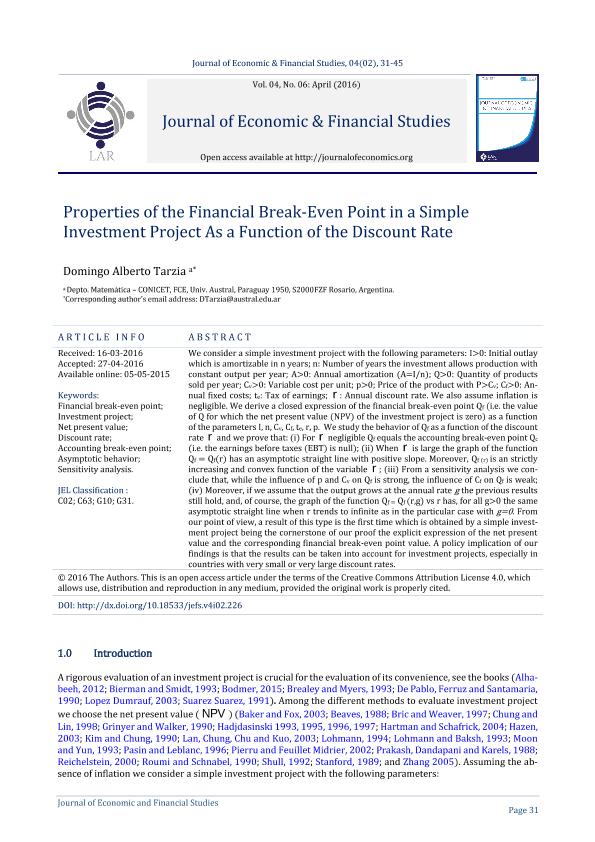Mostrar el registro sencillo del ítem
dc.contributor.author
Tarzia, Domingo Alberto

dc.date.available
2018-09-26T17:35:43Z
dc.date.issued
2016-05
dc.identifier.citation
Tarzia, Domingo Alberto; Properties of the Financial Break-Even Point in a Simple Investment Project As a Function of the Discount Rate; LAR Center Press; Journal of Economic & Financial Studies; 4; 2; 5-2016; 31-45
dc.identifier.issn
2379-9471
dc.identifier.uri
http://hdl.handle.net/11336/60904
dc.description.abstract
We consider a simple investment project with the following parameters: I>0: Initial outlay which is amortizable in n years; n: Number of years the investment allows production with constant output per year; A>0: Annual amortization (A=I/n); Q>0: Quantity of products sold per year; Cv>0: Variable cost per unit; p>0; Price of the product with P>Cv; Cf>0: Annual fixed costs; te: Tax of earnings; : Annual discount rate. We also assume inflation is negligible. We derive a closed expression of the financial break-even point Qf (i.e. the value of Q for which the net present value (NPV) of the investment project is zero) as a function of the parameters I, n, Cv, Cf, te, r, p. We study the behavior of Qf as a function of the discount rate and we prove that: (i) For negligible Qf equals the accounting break-even point Qc (i.e. the earnings before taxes (EBT) is null); (ii) When is large the graph of the function Qf = Qf(r) has an asymptotic straight line with positive slope. Moreover, Qf (r) is an strictly increasing and convex function of the variable ; (iii) From a sensitivity analysis we conclude that, while the influence of p and Cv on Qf is strong, the influence of Cf on Qf is weak; (iv) Moreover, if we assume that the output grows at the annual rate g the previous results still hold, and, of course, the graph of the function Qf = Qf (r,g) vs r has, for all g>0 the same asymptotic straight line when r trends to infinite as in the particular case with g=0. From our point of view, a result of this type is the first time which is obtained by a simple investment project being the cornerstone of our proof the explicit expression of the net present value and the corresponding financial break-even point value. A policy implication of our findings is that the results can be taken into account for investment projects, especially in countries with very small or very large discount rates.
dc.format
application/pdf
dc.language.iso
eng
dc.publisher
LAR Center Press
dc.rights
info:eu-repo/semantics/openAccess
dc.rights.uri
https://creativecommons.org/licenses/by-nc-sa/2.5/ar/
dc.subject
Financial Break-Even Point
dc.subject
Net Present Value
dc.subject
Discount Rate
dc.subject
Investment Project
dc.subject.classification
Economía, Econometría

dc.subject.classification
Economía y Negocios

dc.subject.classification
CIENCIAS SOCIALES

dc.title
Properties of the Financial Break-Even Point in a Simple Investment Project As a Function of the Discount Rate
dc.type
info:eu-repo/semantics/article
dc.type
info:ar-repo/semantics/artículo
dc.type
info:eu-repo/semantics/publishedVersion
dc.date.updated
2018-09-21T12:54:20Z
dc.journal.volume
4
dc.journal.number
2
dc.journal.pagination
31-45
dc.journal.pais
Estados Unidos

dc.description.fil
Fil: Tarzia, Domingo Alberto. Universidad Austral. Facultad de Ciencias Empresariales. Departamento de Matemáticas; Argentina. Consejo Nacional de Investigaciones Científicas y Técnicas; Argentina
dc.journal.title
Journal of Economic & Financial Studies
dc.relation.alternativeid
info:eu-repo/semantics/altIdentifier/url/https://www.journalofeconomics.org/index.php/site/article/view/226
dc.relation.alternativeid
info:eu-repo/semantics/altIdentifier/doi/http://dx.doi.org/10.18533/jefs.v4i02.226
Archivos asociados
